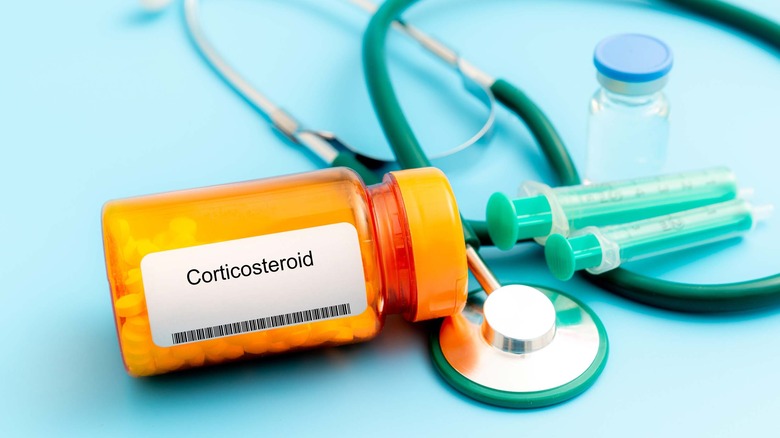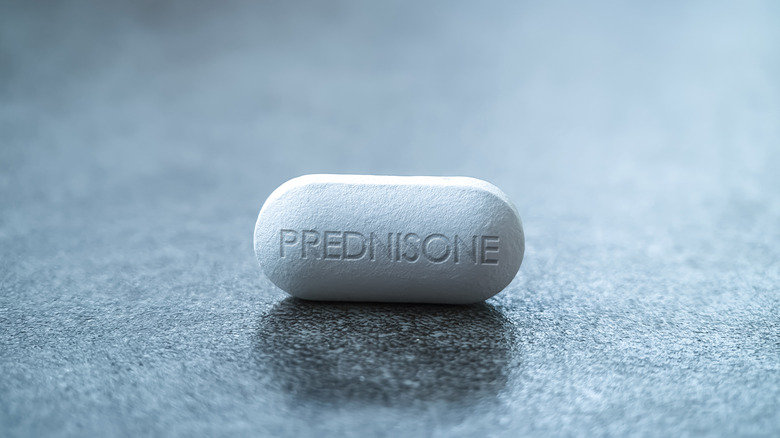What Is The Difference Between Methylprednisolone And Prednisone
Corticosteroids are anti-inflammatory drugs used to treat inflammation-related conditions like rheumatoid arthritis, lupus, or inflammation of the blood vessels (via Cleveland Clinic). They are man-made versions of cortisol, the hormone produced in your adrenal glands that minimizes inflammation. The adrenal hormone cortisol fulfills vital tasks in the human body. According to WebMD, it is a stress hormone that controls the sleep/wake cycle and boosts energy.
For people with inflammatory conditions, doctors often prescribe corticosteroids in doses higher than the body's usual levels, which allows the drug to suppress inflammation (via the Mayo Clinic). Beyond inflammation, corticosteroids are used to treat conditions such as eczema, hay fever, and hives, per Healthline.
According to the Cleveland Clinic, methylprednisolone and prednisone are two common corticosteroid medications. However, even though they belong to a specific class of medicines, there is a difference between methylprednisolone and prednisone. Generally speaking, corticosteroid medications are available in several forms. They often vary in how they dissolve or the time spent in the body. Continue reading for more detailed information on methylprednisolone and prednisone.
Differences between methylprednisolone and prednisone
As mentioned, methylprednisolone and prednisone share many similarities since they belong to the same class of drugs. However, corticosteroids can be systemic or localized, according to Healthline. Local corticosteroids target a specific part of the body while systemic corticosteroids can move through the bloodstream affecting more parts of the body.
According to Medical News Today, doctors usually prescribe methylprednisolone as an injection or orally. However, prednisone is usually only available as an oral treatment. Since methylprednisolone goes directly into the bloodstream, it's more suitable for people who can't easily absorb oral medications, per Medical News Today. This also means that prednisone is generally only used systemically whereas methylprednisone can be used either systemically or locally.
Methylprednisolone is also slightly stronger than prednisone, according to Drugs.com. Due to this, health experts may prescribe methylprednisolone in lower doses than prednisone. Drugs.com adds that oral prednisone is the most preferred corticosteroid option in the United States, while methylprednisolone is more common in Europe. Despite their differences, both drugs are anti-inflammatory and immunosuppressive and can help treat various autoimmune and respiratory conditions.
Side effects of methylprednisolone and prednisone
According to Healthline, side effects can occur regardless of whether you take an injected or oral form of corticosteroids. People on methylprednisolone can experience skin problems, muscle weakness, swelling of the ankles, and unexplained weight gain (per Medical News Today).
Methylprednisolone can decrease your body's ability to fight infections, making you more susceptible to life-threatening infections, according to WebMD. According to the source, methylprednisolone can also elevate blood sugar levels in people with diabetes and might worsen typical symptoms like frequent urination. It's important to report any unusual symptoms to your doctor. Call your doctor immediately if you experience symptoms of intestinal bleeding, mood changes, slow wound healing, or irregular heartbeats.
Since prednisone is also a corticosteroid, you might experience similar side effects to methylprednisolone. According to the Mayo Clinic, the common side effects of prednisone include nausea, vomiting, loss of appetite, heartburn, problems sleeping, increased sweating, or acne.
According to the source, prednisone may, in some rare cases, trigger a rise in blood sugar which may cause or worsen diabetes. Using the medication can also trigger anaphylaxis in users who are allergic to it.
Please note that this is not a full listing of all possible side effects. Please consult the package insert or your doctor or pharmacist for more details.



